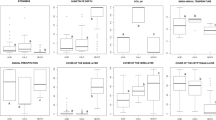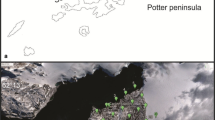Abstract
Alpine ecosystems are important monitoring targets for examining climate-induced changes in biodiversity components. In this context, by following the protocol of the Global Observation Research Initiative in Alpine environments, two target regions (TR) were established in the mountainous regions of the Chaudans and Byans valleys of Uttarakhand. Lichens along with some vascular plants dominate alpine ecosystems and are known to play a pivotal role in ecosystems. Lichens are well known bioindicators of climatic conditions, hence the present study is focused on lichen diversity and distribution in selected TRs. We established 08 (04 in each TR) summits (covering different alpine zones from treeline to nival belt). The data sets regarding species richness, distribution, frequency, cover etc. were generated. We reported 30 species belonging to 25 genera and 17 families collected at eight alpine mountain summits in TR—I and II. With plans to monitor and resurvey at five-year intervals, the sites established in this project document current lichen species composition, and allow for a long-term assessment of changes in biodiversity attributable primarily to changes in climate. The dataset generated can be compared with the datasets of other high-altitude regions of the globe.





Similar content being viewed by others
Data availability
All data of lichens based on the GLORIA sites that support the findings of this study are included within this paper and its Supplementary Information files.
Abbreviations
- GLORIA:
-
Global Observation Research Initiative in Alpine environments
- TR:
-
Target regions
- IHR:
-
Indian Himalayan Region
- KSLCDI:
-
Kailash Sacred Landscape Conservation and Development Initiative
- KSL:
-
Kailash Sacred Landscape
- ICIMOD:
-
International Canter for Integrated Mountain Development
- N, S, E and W:
-
North, South, East and West
- HSP:
-
Highest summit point HSP
- SASs:
-
Summit area sections
- m:
-
Meter
- cm:
-
Centimeter
- r!:
-
Very rare (one or a few individuals)
- r:
-
Rare (some individuals at several locations, can hardly be overlooked in a careful observation)
- s:
-
Scattered (widespread within the section, species cannot be overlooked, but the presence is not obvious at first glance)
- c:
-
Common (occurring frequently and widespread within the section, presence is obvious at first glance)
- d:
-
Dominant (very abundant)
- PCA:
-
Principal Component Analysis
References
Aptroot A (2009) Lichens as an indicator of climate and global change. In: Letcher TM (ed) Climate change: observed impacts on planet Earth. Elsevier, Oxford, pp 401–408
Awasthi DD (1991) A key to microlichens of India, Nepal and Sri Lanka. Bibl Lichenol 40:1–337
Awasthi DD (2007) A compendium of the macrolichens from India, Nepal and Sri Lanka. Bishen Singh Mahendra Pal Singh Publication, Dehra Dun
Bisht K (2018) Impact of climate change on glaciers of Kumaun Himalaya: a lichenometric approach. PhD, Kumaun University Nainital, Uttarakhand, India
Bisht K, Joshi Y, Upadhyay S, Mehta P (2018a) Recession of Milam Glacier, Kumaun Himalaya, observed via lichenometric dating of moraines. J Geol Soc India 92:173–176. https://doi.org/10.1007/s12594-018-0977-8
Bisht K, Joshi Y, Upadhyay S, Chandra K (2018b) Assessment of climate change impact on recession of Adi Kailash glacier, Kumaun Himalaya: a lichenometric observation. ENVIS Bull Him Ecol 25:24–27
Bisht K, Upadhyay S, Joshi Y (2019) Timberline forests: potential habitats for conserving Himalayan medicinal lichen diversity in Kailash sacred landscape part of India. ENVIS Bull Him Ecol 26:39–46
Bisht K, Upadhyay S, Joshi Y (2020) Higher growth rates of saxicolous lichens in alpine regions of Western Himalaya - a consequence of warming climate. ENVIS Bull Him Ecol 27:69–72
Chandra Sekar K, Rawal RS, Chaudhery A et al (2017) First GLORIA site in Indian Himalayan Region: towards addressing issue of long-term data deficiency in the Himalaya. Natl Acad Sci Lett 40:355–357. https://doi.org/10.1007/s40009-017-0584-z
Dhar U (2000). Prioritization of conservation sites in the timberline zone of west Himalaya. In: Singh S, Sastry ARK, Mehta R, Uppal V (eds) Setting biodiversity conservation priorities for India, pp 193–211
Divakar PK, Upreti DK (2005) Parmelioid lichens in India. A revisionary study. Bishen Singh Mahendra Pal Singh Publication, Dehra Dun
Dullinger S, Kleinbauer I, Pauli H et al (2007) Weak and variable relationships between environmental severity and small-scale co-occurrence in alpine plant communities. J Ecol 95:1284–1295. https://doi.org/10.1111/j.1365-2745.2007.01288.x
Gairola S, Rawal RS, Todaria NP (2015) Effect of anthropogenic disturbance on vegetation characteristics of sub-alpine forests in and around Valley of Flowers National Park, a world heritage site of India. Trop Ecol 56:357–365
Grabherr G, Gottfried M, Pauli H (2001) Long-term monitoring of mountain peaks in the Alps. In: Burga CA (ed) Biomonitoring: General and applied aspects on regional and global scales. Tasks for vegetation science, vol 35. Kluwer, Philadelphia
Grabherr G, Gottfried M, Pauli H (2010) Climate change impacts in alpine environments. Geogr Compass 4:1133–1153. https://doi.org/10.1111/j.1749-8198.2010.00356.x
Hammer O, Harper DAT, Ryan DP (2001) PAST: paleontological statistics software packages for education and data analysis. Palaeontol Electron 4:9
Hawksworth DL, Iturriaga T, Crespo A (2005) Líquenes como bioindicadores inmediatos de contaminación y cambios medioambientales en los trópicos. Rev Iberoam Micol 22:71–82
Joshi S (2010) Diversity of lichens in Pindari and Milam region of Kumaun Himalayas. Ph.D. Thesis, Kumaun University, Nainital
Joshi S, Upreti DK, Punetha N (2008a) Lichen flora of Munsiyari, Khaliya Top and Kalamuni in Pithoragarh district of Uttarakhand. Phytotaxonomy 7:50–55
Joshi S, Upreti DK, Punetha N (2008b) Change in Lichen flora of Pindari Glacier during the last three decades. Ann for 16:168–169
Joshi Y, Upadhyay S, Shukla S et al (2016) Sacred groves: treasure house for macrolichen diversity in Kumaun Himalaya. Proc Natl Acad Sci India Sect B Biol Sci. https://doi.org/10.1007/s40011-016-0832
Joshi Y, Tripathi M, Bisht K et al (2018a) Further contributions to the documentation of lichenicolous fungi from India. Kavaka 50:26–33
Joshi Y, Bisht K, Upadhyay S et al (2018b) Three new records of lichens from India. Nelumbo 60:90–94. https://doi.org/10.20324/nelumbo/v60/2018/122642
Körner C (2002) Mountain biodiversity, its causes and function: an overview. In: Körner C, Spehn E (eds) Mountain biodiversity—a global assessment. Parthenon, London, pp 3–20
McCune B (2000) Lichen communities as indicators of forest health. Bryologist 103:353–356. http://www.jstor.org/stable/3244162
Mishra GK, Upreti DK (2016) Diversity and distribution of macrolichen in Kumaun Himalaya, Uttarakhand. Int J Adv Res 4:912–925
Nanda SA, Haq M, Singh SP et al (2021) Species richness and β-diversity patterns of macrolichens along elevation gradients across the Himalayan Arc. Sci Rep 11(1):20155. https://doi.org/10.1038/s41598-021-99675-1
Negi CS (2010) The institution of Taboo and the local resource management and conservation surrounding sacred natural sites in Uttarakhand, Central Himalayas. Int J Biodivers Conserv 2:186–195
Orange A, James PW, White FJ (2001) Microchemical methods for the identification of lichens. British Lichen Society, London
Pant V (2002). Biodiversity of lichens in botanical hot spots of Pithoragarh district, Uttaranchal. PhD, Kumaon University Nainital, Uttarakhand, India
Pauli H, Gottfried M, Grabherr G (1996) Effects of climate change on mountain ecosystems—upward shifting of alpine plants. World Resour Rev 8:382–390
Pauli H, Gottfried M, Hohenwallner D et al (2004) GLORIA field manual: multi‐summit approach. Global observation research initiative in Alpine Environments. European Communities, Luxemburg, Belgium
Pauli H, Gottfried M, Hohenwallner D et al. (2011) GLORIA field manual: multi‐summit approach with notes referring to a manual update. Global observation research initiative in Alpine environments. European Communities, Luxemburg, Belgium
Price MF, Barry RG (1997) Climate change. In: Messerli B, Ives JD (eds) Mountains of the world. Parthenon Publishing, New York, pp 409–445
Sancho LG, Pintado A (2004) Evidence of high annual growth rate for lichens in the maritime Atlantic. Polar Biol 27:312–319. https://doi.org/10.1007/s00300-004-0594-4
Scheidegger C, Groner U, Keller C et al (2002) Biodiversity assessment tools-lichens. In: Nimis PL, Scheidegger C, Wolseley PA (eds) Monitoring with lichens-monitoring lichens. Kluwer Academic, Dordrecht, pp 359–365
Theurillat JP (1995) Climate change and the alpine flora: some perspectives. In: Guisan A, Holten JI, Spichiger R, Tessier L (eds) Potential ecological impacts of climate change in the Alps and Fennoscandian mountains. Genéve, Conserv. Jard. Bot., pp 121–127
Upadhyay S (2017) Distribution and diversity pattern of macrolichens along an altitudinal gradient in Kumaun Himalaya with an emphasis to their indicator value. Ph.D. thesis, Kumaun University, Nainital
Upadhyay S, Jugran AK, Joshi Y, Suyal R, Rawal RS (2018) Ecological variables influencing the diversity and distribution of epiphytic macrolichens colonizing Quercus leucotrichophora in Thal Ke Dhar forest, Pithoragarh district, Uttarakhand. J Mt Sci 1:1. https://doi.org/10.1007/s11629-017-4397-9
Upreti DK, Pant V, Divakar PK (2001) Distribution of lichens in Askot-Sandev botanical hot spot of Pithoragarh district, Uttar Pradesh. Phytotaxonomy 1:40–45
Upreti DK, Pant V, Divakar PK (2002) Exploitation of lichens from Pithoragarh district, Uttaranchal. Ethnobotany 14:60–62
van Herk CM, Aptroot A, van Dobben HF (2002) Long-term monitoring in the Netherlands suggests that lichens respond to global warming. Lichenologist 34:141–154. https://doi.org/10.1006/lich.2002.0378
Vittoz P, Camenisch M, Mayor R et al (2010) Subalpine-nival gradient of species richness for vascular plants, bryophytes and lichens in the Swiss Inner Alps. Bot Helv 120:139–149. https://doi.org/10.1007/s00035-010-0079-8
Zomer R, Oli KP (2011) Kailash Sacred Landscape Conservation Initiative (KSLCI), Feasibility Assessment Report, International Center for Integrated Mountain Development, Kathmandu
Acknowledgements
Authors are grateful to the Kailash Sacred Landscape Conservation and Development Initiative (KSLCDI) facilitated by the International Center for Integrated Mountain Development (ICIMOD) for providing financial support to conduct field activity in district Pithoragarh. Thanks are due to the Director, GBP-NIHE for providing laboratory facilities. We are thankful to the NMSHE (National Mission for Sustaining the Himalayan Ecosystem) Task Force—3, Lead Botanical Garden Project (Lead-BG, MoEF&CC, F.N. BSI-290/6/2013-Tech; Date- 29/09/2013), National Mission on Himalayan Studies (NMHS-Himalayan Fellowship Programme) and the entire team of researchers involved in the field activity carried out in both sites.
Author information
Authors and Affiliations
Corresponding authors
Ethics declarations
Conflict of interest
The authors do not have any conflict of interest.
Additional information
Publisher's Note
Springer Nature remains neutral with regard to jurisdictional claims in published maps and institutional affiliations.
Supplementary Information
Below is the link to the electronic supplementary material.
Rights and permissions
Springer Nature or its licensor (e.g. a society or other partner) holds exclusive rights to this article under a publishing agreement with the author(s) or other rightsholder(s); author self-archiving of the accepted manuscript version of this article is solely governed by the terms of such publishing agreement and applicable law.
About this article
Cite this article
Bisht, K., Upadhyay, S., Sekar, K.C. et al. Establishment of GLORIA sites in Indian Himalayan Region: diversity and distribution of lichens. Vegetos (2023). https://doi.org/10.1007/s42535-023-00629-x
Received:
Revised:
Accepted:
Published:
DOI: https://doi.org/10.1007/s42535-023-00629-x




